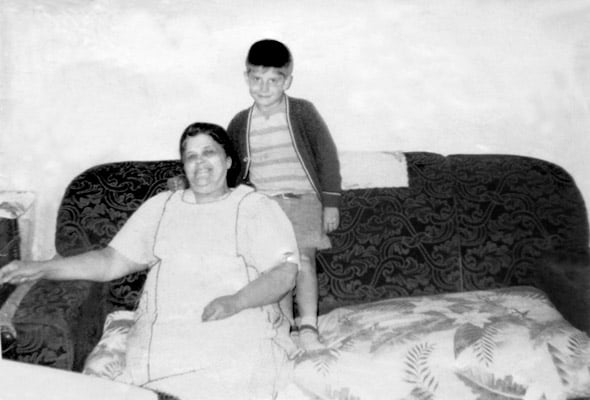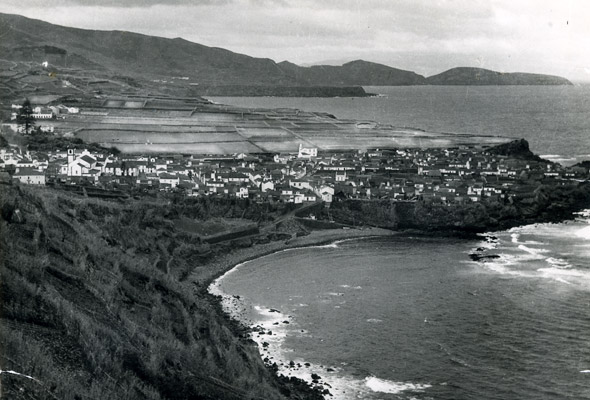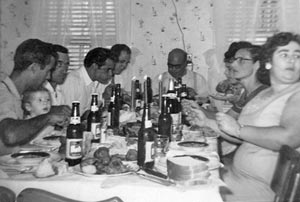

Clearly, something had to be done. So I approached my mother and aunts with a sheepish grin on my face and a video camera in my hand. My goal: to film family favorites being prepared before they too were lost. I wanted a permanent record of the food that filled three tables every Sunday when we laughed and talked (which to other families sounded like fighting), and my mother and aunts buzzed about happily shoveling their specialties onto our plates.

While they were eager to squeeze their way into the viewfinder, capturing their culinary heirlooms proved daunting. For example, there must have been a shortage of measuring cups and spoons in the Azores, because my mother and aunts cook only with pinches of this and handfuls of that. I had to yell “CUT!” more times than I care to recall to fish out a mound of parsley from boiling broth or catch a fistful of garlic midair in order to measure it properly.
Vocabulary proved another sticking point. While the National Live Stock and Meat Board categorizes beef into no fewer than 45 different cuts, it’s all just “meat” to my mother. Any further questioning was met with a shrug of her shoulders and — as if I were asking about sex — the admonition to discuss it with my father. In her intuitive, cookbook-free world, there were no fancy names or elaborate techniques. You simply rolled up your sleeves and began chopping.
But over time the recipes, as well as forgotten bits of family history, revealed themselves. I remembered summer days spent shucking fava beans with VoVo in her kitchen. And even though she sat there in just her slip plonking beans into a big white washtub at her feet, she looked like an empress. I joked with my mother about the ridiculous amount of food she makes every October for family and friends who help my father harvest his grapes for wine. Believe it or not, I even developed an appreciation, but certainly not a taste, for my Aunt Irene’s octopus stew.

I came to accept that our food defines us, whether we’re sitting at the kitchen table or not. Simply put, we are a family of immigrants — something I denied as a teenager by idolizing Big Macs and the Colonel’s original recipe. Anything to deep-six the Portuguese part of my Portuguese-American heritage.
Well, not any longer. My first visit to the Azores is scheduled for next fall. To prepare, I’m learning Portuguese, much to the hilarity of everyone. But most important, whenever I crave a taste of home, I just pop a cassette into the VCR and follow along with my mother and aunts — to me, the best collection of chefs on TV.












It was fun reading this article, but I got a special kick out of looking at the dining table photo. I’m an east coast American (Boston mother, N.Y. father, and D.C. with a Cape Cod– summers only–upbringing). I now live in Portugal with my Portuguese husband. I’ve sat at many tables that look just like this! Granted, when it’s at our house it may well include Bulgarians, Germans, English, and Canadians digging in, but the food is always Portuguese and the wine bottles abound! When we were still in the States, we had for five years a Portuguese restaurant (my husband was the chef) where the tables tended to look pretty much the same! :>) Thank you.
KarenJ, that’s what I love about food. No matter what your background we all can relate. Tell me: 1.) Where in Portugal are you?, and 2.) Where was your husband’s restaurant?
Loved this writing. Even though I am not your traditional immigrant (we lived all over the world and were fortunate to go back home at least once a year and lived there a total of 7 years–three different times), I must say my grandmother is also a tremendous influence in how I cook today. She usually would also not use measuring cups or spoons but luckily she would write down all the recipes she made throughout her life. I am now slowly going through her books (I inherited) of traditional Portuguese cooking, her own interpretations and from all over the world as she too was a traveler.
It’s the way with that generation, Sofia. Let’s hope we can pass in on to the next.
I had fun reading this because it reminds me of my own family and, I have to say, myself. I learned how to cook with pinches of this and dashes of that, and I think that’s so intuitive! That’s genuine cuisine to me; feeling the food being cook and accomplishing to its needs. I’m from Portugal, recently living in USA, and I had just discover your website, after hearing about your book. I have to say I know most of the Portuguese recipes you have here by memory and I’m thrilled that you’re showing the flavors of Portugal like that. Thank you.
Teresa, I’m delighted you found Leite’s Culinaria and that you enjoy the recipes here. I hope to add more Portuguese dishes soon.